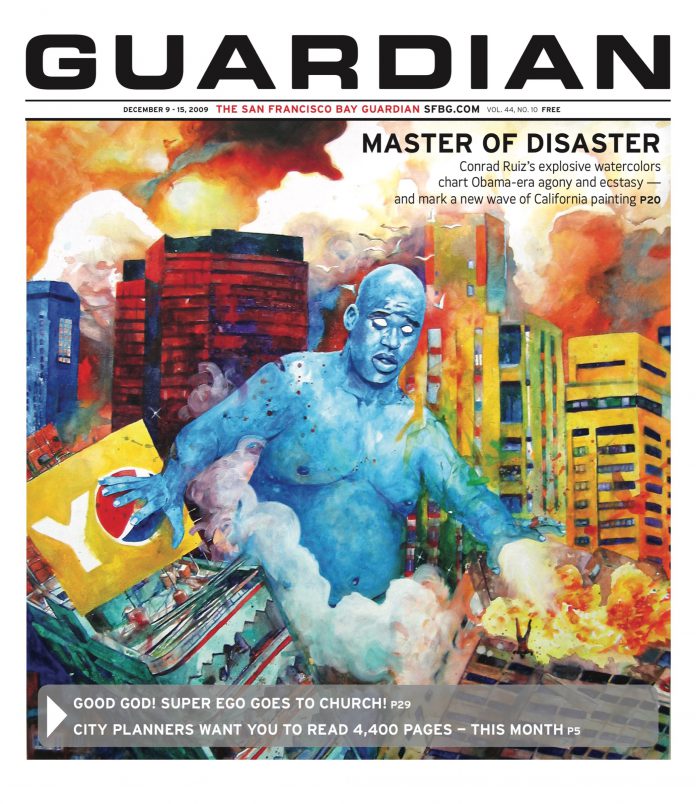EDITORIAL The Candlestick Point redevelopment project is by far the biggest land-use decision facing San Francisco today, and one of the most significant in the city’s modern history. The project, sponsored by Lennar Corp., would bring 10,500 housing units and 24,000 additional residents to the area. Those residents would need new schools, playgrounds, open space, and transportation systems. Industrial and commercial development would create some 3,500 permanent jobs, and those people would need ways to get to work. Plans calls for new roadways, including a bridge over the fragile Yosemite Slough. The 708-acre site includes areas with significant toxic waste issues.
It’s no surprise that the draft environmental impact report on the project weighs in at 4,400 pages. It took two years to review the land use, transportation, air quality, water quality, population, employment, noise, hazardous materials, and other potential issues.
And now the Planning Department and Redevelopment Agency wants all public comment to be completed in a 45-day period that includes the winter holidays. That’s crazy – and it’s a sign that the city just wants to rush this project through without adequate oversight, review, or discussion.
The EIR in a project this size is a major political battleground. It’s one of the few times that the Planning Commission and Board of Supervisors will get to weigh in on the entire project and look at its local and citywide impacts. It’s quite possibly the only time prior to construction when the economic, social, and environmental issues around the project will get widespread public discussion.
And anyone who reads these reports on a regular basis can tell you that they’re thick, dense, tough to follow, and filled with minute details and arcana that add up to very big policy decisions. Among the most pressing issues:
• The housing mix. The city’s own General Plan notes that almost two-thirds of all new housing built in San Francisco needs to be available at below-market rates. Lennar won’t even meet half that target. So the project would create an even greater unmet demand for affordable housing something the EIR, at least on first read, glosses over. The report refers to “a broad range of housing options of varying sizes, types, and levels of affordability [that would] be developed at Candlestick Point” and states that “such housing would be in close proximity to the jobs provided by the project, [so] it is likely that future employees at Candlestick Point would seek housing at the project site prior to searching for housing in the surrounding Bayview-Hunters Point neighborhood. However, if future employees did seek housing elsewhere in the neighborhood, the effects would not be adverse.”
Actually, if comparatively well-paid employees at the project’s research and development facilities decided to move into the existing Hunters Point/Bayview neighborhood, it would almost certainly drive up housing prices, displacing existing residents.
• Transportation options. The project projects significant improvements in Muni service but doesn’t say how the city will pay for them. There’s a sizable focus on cars the EIR estimates the project will need more than 21,000 parking spaces. That’s a lot more cars on the streets of the city, a lot more traffic in the southeast and a direct clash with the city’s transit-first policies.
• What jobs, and for whom? The 3,500 permanent jobs that would be created are badly needed in that neighborhood, which has the highest unemployment rate in the city. But a comprehensive labor pool study, and a discussion of how existing residents will be trained for projected jobs, appears to be missing from the EIR.
• Hazardous materials. The EIR broadly proclaims that “construction activities associated with the project would not result in a human health risk involving the disturbance of naturally occurring asbestos, demolition of buildings that could contain hazardous substances in building materials, or possible disturbance of contaminated soils or groundwater within one-quarter mile of an existing school.” That is at the very least a matter of some dispute.
There’s lots more – 4,400 pages more – and if the approval process is going to be anything other than an utter farce, the Planning and Redevelopment directors need to extend the public comment period for at least another 45 days. *

